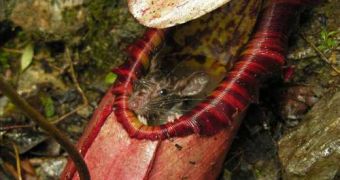While on a trekking trip atop Mount Victoria, a remote mountain in Palawan, the Philippines, a group of Christian missionaries stumbled in 2002 upon a plant they had never seen before, and which appeared to be very large and carnivorous. In a recent study, published in the latest issue of the Botanical Journal of the Linnean Society, naturalists and botanists have been finally able to confirm that the new organism is the world's second-largest pitcher plant, and that it is able to consume everything from insects and bugs to rodents and frogs.
The South Asian species, known by the catchy name Nepenthes attenboroughii, is second only to Nepenthes rajah, the largest carnivorous plant ever discovered to date. It grows to be up to four feet tall, and its pitcher-shaped structure is laden with nectar, which is used as bait. When animals or insects approach the plant to feast on the treat, they slip into the opening, and drown in the liquid contained within. Their drowned carcasses are then dissolved and consumed by the enzymes and acids in the liquid.
“All carnivorous plants have evolved to catch insects but the biggest ones, such as this one, can eat rats and frogs. It’s truly remarkable that a plant this big has been undiscovered for so long,” Stewart McPherson, who is an expert at the Red Fern Natural History Productions, and also the leader of the research team that analyzed the plant, told LiveScience.
Following the impressive find, McPherson reported that some people actually asked him if cultivating the plant in cities such as New York, which have notorious rat issues, could help fix the problem. “Mice and rats are attracted to the sweet nectar of the plant, but it only catches them occasionally. It just isn’t practical. There will be too many mice for the plant to catch anyways,” the expert replied.
The discovery of the plant came as a shock to the scientific community, mostly because no one expected such a large plant to remain undiscovered for such a long time. Naturally, missing species that grow to smaller sizes is only human, but a four-foot plant jumps in your face, so to speak. And especially if it's a carnivorous one.

 14 DAY TRIAL //
14 DAY TRIAL //